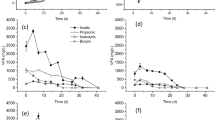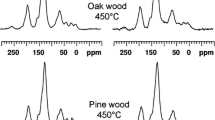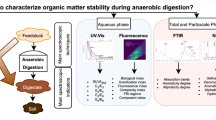Abstract
The ease and simplicity of applying the anaerobic digestion technology in the generation of cheap bioenergy has led to its global acceptance as a viable technique for simultaneous value extraction from high moisture containing waste biomass and organic waste management. Crucially, however, the widespread application of anaerobic digestion technologies results in the associated generation of large masses of raw biogas digestate, leading to unintended digestate management challenges. A previous study subsequently investigated the utilisation of the digestate as a sustainable feedstock for bioproduct generation via the incorporation of the hydrothermal liquefaction (HTL) technology. As a sequel to the aforementioned study, the present work sought to investigate the characteristic properties of the major products of the hydrothermal liquefaction processing of anaerobic digestate while simultaneously proposing viable and practical uses of these products. Several characterisation techniques such as nuclear magnetic resonance spectroscopy, Fourier transform infrared spectroscopy, inductively coupled plasma mass spectrometry and gas chromatograph-mass spectrometry were applied with representative HTL products from digestate employed in this regard.




Similar content being viewed by others
References
Okoro OV, Sun Z, Birch J (2018) Prognostic assessment of the viability of hydrothermal liquefaction as a post-resource recovery step after enhanced biomethane generation using co-digestion technologies. Appl Sci 8(11):https://doi.org/10.3390/app8112290
Okoro OV, Sun Z, (2019) Desulphurisation of Biogas: A Systematic Qualitative and Economic-Based Quantitative Review of Alternative Strategies. Chem Eng 3 (3):76
Logan M, Visvanathan C, (2019) Management strategies for anaerobic digestate of organic fraction of municipal solid waste: Current status and future prospects. Waste Manag & Res 37 (1_suppl):27-39
Baggesen DL (2007) Veterinary safety in relation to handling of manure and animal by products and the use of biogas technologies. In: Presentation National Food Institute Denmark
Hentges DJ (1996) Anaerobes: general characteristics. In: medical microbiology. 4th edition. University of Texas Medical Branch at Galveston, Galveston, Texas
Okoro OV, Sun Z, Birch J (2017) Meat processing waste as a potential feedstock for biochemicals and biofuels – a review of possible conversion technologies. J Clean Prod 142(part 4):1583–1608
Golkowska K, Vázquez-Rowe I, Lebuf V, Accoe F, Koster D (2014) Assessing the treatment costs and the fertilizing value. Water Sci Technol 69(3):656–662
Okoro OV, Zhifa S, Birch J (2019) Thermal depolymerization of biogas digestate as a viable digestate processing and resource recovery strategy. In: Advances in Eco-Fuels for a Sustainable Environment. Wood head publishing Cambridge, pp 277–308
Okoro OV, Sun Z, Birch J (2018) Thermal depolymerisation of digestate for biofuel and biomaterial production. In Proceedings of the 2014th World Congress on New Technologies (NewTech’2018), Madrid, Spain, pp 2019-2021
Biller P, Lawson D, Madsen RB, Becker J, Iversen BB, Glasius M (2017) Assessment of agricultural crops and natural vegetation in Scotland for energy production by anaerobic digestion and hydrothermal liquefaction. Biomass Conv Bioref 7:467–477
Vardon DR, Sharma BK, Scott J, Yu G, Wang Z, Schideman L, Zhang Y, Strathmann TJ (2011) Chemical properties of biocrude oil from the hydrothermal liquefaction of Spirulina algae, swine manure, and digested anaerobic sludge. Bioresour Technol 102(17):8295–8303
ASTM (1998) D2017–98 Standard test method of accelerated laboratory test of natural decay resistance of woods , decay, evaluation, laboratory, natural, resistance and subjected to termite bioassay according to no-choice test procedure based upon AWPA E1–97 (AWPA, 1. West Conshohocken
IBI (2012) IBI biochar standard. Minesota
Domingues RR, Trugilho PF, Silva CA, de Melo ISNA, Melo LCD, Magriotis ZA, Sánchez-Monedero MA (2017) Properties of biochar derived from wood and high-nutrient biomasses with the aim of agronomic and environmental benefits. PLoS One 12(5):e0176884. https://doi.org/10.1371/journal.pone.0176884
ASTM (2015) ASTM D3176–15 Standard practice for ultimate analysis of coal and coke. ASTM International, West Conshohocken
Channiwala SA, Parikh PP (2002) A unified correlation for estimating HHV of solid, liquid and gaseous fuels. Fuel 81:1051–1063
Gai C, Zhang Y, Chenb W, Zhang P, Donga Y (2014) Energy and nutrient recovery efficiencies in biocrude oil produced via hydrothermal liquefaction of Chlorella pyrenoidosa. RSC Adv 4:16958–16967
Barnés MC, de Visser MM, Rossum GV, .Kersten SRA, Lange JP (2017) Liquefaction of wood and its model components. J Anal Appl Pyrolysis 125:136–143
Wu Z, Rodgers RP, Marshall AG (2004) 2 and 3-dimensional van Krevelen Diagrams: a graphical analysis complementary to the Kendrick mass plot for sorting elemental compositions of complex organic mixtures based on ultrahigh-resolution broadband Fourier transform ion cyclotron resonance mass. Anal Chem 76(9):2511–2516
Fryda L, Visser R (2015) Biochar for soil improvement: evaluation of biochar from gasification and slow pyrolysis. Agriculture 5(4):1076–1115
Luo L, Sheehan JD, Dai L, Savage PE (2016) Products and kinetics for isothermal hydrothermal liquefaction of soy protein concentrate. ACS Sustain Chem Eng 4:2725–2733
Chen W-T, Zhang Y, Zhang J, Yu G, Schideman LC, Zhang P, Minarick M (2014) Hydrothermal liquefaction of mixed culture algal biomass from wastewater treatment system into biocrude oil. Bioresour Technol 152:130–139
Vardon DR, Sharma BK, Blazina GV, Rajagopalan K, Strathmann TJ (2012) Thermochemical conversion of raw and defatted algal biomass via hydrothermal liquefaction and slow pyrolysis. Bioresour Technol 109:178–187
Chen W-T, Zhang Y, Zhang J, Yu G, Schideman LC, Zhang P et al (2014) Co- liquefaction of swine manure and mixed- culture algal biomass from wastewater treatment system to produce biocrude oil. Appl Energy 128:209–216
Mullen CA, Strahan GD, Boateng AA (2009) Characterization of various fast-pyrolysis bio-oils by NMR spectroscopy. Energy Fuel 23:2707–2718
Özbay N, Apaydın-Varol E, Uzun BB, Pütün AE (2008) Characterization of bio-oil obtained from fruit pulp pyrolysis. Energy 33:1233–1240
Cheng F, Cui F, Chen L, Jarvis J, Paz N, Schaub T, Nirmalakhandand N, Brewera CE (2017) Hydrothermal liquefaction of high- and low-lipid algae: bio-crude oil chemistry. Appl Energy 206:278–292
Qian Y, Zuo C, Tan J, He J (2007) Structural analysis of bio-oils from sub-and supercritical water liquefaction of woody biomass. Energy 32(3):196–202
Zhang L, Shen C, Liu R (2014) GC–MS and FT-IR analysis of the bio-oil with addition of ethyl acetate during storage. Front Energy Res. https://doi.org/10.3389/fenrg.2014.00003
Jena U, Das KC (2011) Comparative evaluation of thermochemical liquefaction and pyrolysis for bio-oil production from microalgae. Energy Fuel 25:5472–5482
Li H, Yuan X, Zeng G, Huang D, Huang H, Tong J, You Q, Zhang J, Zhou M (2010) The formation of bio-oil from sludge by deoxy-liquefaction in supercritical ethanol. Bioresour Technol 101:2860–2866
Karagöz S, Bhaskar T, Muto A, Sakata Y (2005) Comparative studies of oil compositions produced from sawdust, rice husk, lignin and cellulose by hydrothermal treatment. Fuel 84:875–884
Chumpoo J, Prasassarakich P (2010) Bio-oil from hydro-liquefaction of bagasse in supercritical ethanol. Energy Fuel 24:2071–2077
API (2011) Crude oil: CAS No. 8002-05-9. American Petroleum Institute, Washington D.C.
Flagan RC, Seinfeld JH (1988) Combustion fundamentals. In: Fundamentals of air pollution engineering. Prentice-Hall, Englewood Cliffs, pp 59–166
Demirbas A (2002) Relationships between heating value and lignin, moisture, ash and extractive contents of biomass fuels. Energy Explor Exploit 20:105–111
Al-arenan S, Alkathiri N, Al-Rashed Y, Doshi T, Alfawzan Z, Six S, Yermankov V (2016) GCC-NEA oil trade: competition in asian oil markets and trhe Russian ‘pivot’ east in: energy relations and policy making in Asia. Springer, Singapore
Makinde I, Lee WJ (2016) Reservoir simulation models – impact on production forecasts and performance of shale volatile oil reservoirs. Glob J Res Eng Gen Eng 16(4):53–69
Kayan C (2012) Systems of units: National and International Aspects. Literary Licensing, Califonia
Campbell J (2014a) Simple equations to approximate changes to the properties of crude oil with changing temperature. https://www.petroskills.com/blog/entry/crude-oil-and-changing-temperature#.XeEP4Ogzbcs/. Accessed 2 Nov 2018
ASTM (2013) Standard test method for specific gravity and density of semi-solid bituminous materials (Pycnometer Method)ASTM D70–03 American Society for Testing and Materials International, West Conshohocken
Chintala R, Mollinedo J, Schumacher TE, Malo DD, Julson JL (2014) Effect of biochar on chemical properties of acidic soil. Arch Agron Soil Sci 60:393–404
Thies JE, Rillig MC (2009) Characteristics of biochar: biological properties (Ch. 6). In: Biochar for environmental management. Earthscan, Gateshead, pp 85–105
Rutherford DW, Wershaw RL, Rostad CE, Kelly CN (2012) Effect of formation conditions on biochars: compositional and structural properties of cellulose, lignin, and pine biochars. Biomass Bioenergy 46:693–701
Vantieghem S (2016) Carbon dioxide sequestration by means of biochar: analytical pyrolysis as a stability proxy method. Faculty of Bioscience Engineering: Gent University Gent
Jindo K, Sonoki T, Matsumoto K, Canellas L, Roig A, Sanchez-Monedero MA (2016) Influence of biochar addition on the humic substances of composting manures. Waste Manag 49:545–552. https://doi.org/10.1016/j.wasman.2016.01.007
Goulding KWT (2016) Soil acidification and the importance of liming agricultural soils with particular reference to the United Kingdom. Soil Use Manag 32:390–399
Carmo DL, Silva CA, Lima JM, Pinheiro GC (2016) Electrical conductivity and chemical composition of soil solution: comparison of solution samplers in tropical soils. Rev Bras Ciênc Solo 40:e0140795
IBI (2015) IBI Biochar Standards Version 2.0. International biochar initiative, US
Lenntech (2019) Water conductivity. In: https://www.lenntech.com/applications/ultrapure/conductivity/water-conductivity.htm./. Accessed 11 Oct 2018
Filiberto DM, Gaunt JL (2013) Practicality of biochar additions to enhance soil and crop productivity. Agriculture 3(4):715–725
Nair VD, KR NP, Dari B, Freitas AM, Chatterjee N, Pinheiro FM (2017) Biochar in the agroecosystem–climate-change–sustainability nexus. Front Plant Sci 8.https://doi.org/10.3389/fpls.2017.02051
Asad A, Rafique R (2000) Effect of zinc, copper, iron, manganese and boron on the yield and yield components of wheat crop in tehsil Peshawar. Pak J Biol Sci 3(10):1615–1620
Burton LD (2009) Agriscience fundamentals and applications, 5th edn. Cengage learning, New York
Subbarao GV, Ito O, Berry WL, Wheeler RM (2003) Sodium—a functional plant nutrient. Crit Rev Plant Sci 22(5):391–416
Lyu S, Wei X, Chen J, Wang C, Wang X, Pan D (2017) Titanium as a beneficial element for crop production. Front Plant Sci 8:597. https://doi.org/10.3389/fpls.2017.00597
Bojórquez-Quintal E, Escalante-Magaña C, Echevarría-Machado I (2017) Aluminum, a friend or foe of higher plants in acid soils. Front Plant Sci 8. https://doi.org/10.3389/fpls.2017.01767
Rout G, Samantaray S, Das P (2001) Aluminium toxicity in plants: a review. Agronomie, EDP Sciences 21(1):3–21
EIA (2017) distillate fuel oil U.S. Energy Information Administration, Washinton D.C.
Apex (2015) FUEL OIL NO. 6, Safety Data Sheet. Apex oil company Inc., Missouri
Gaur S, Reed TB (1998) Thermal data for natural and synthetic fuels. Marcel Dekker, New York
Okoro OV, Sun Z, Birch J (2017) Meat processing dissolved air flotation sludge as a potential biodiesel feedstock in New Zealand: a predictive analysis of the biodiesel product properties. J Clean Prod 168:1436–1447
Feng S, Yuan Z, Leitch M, Xu CC (2014) Hydrothermal liquefaction of barks into bio-crude – effects of species and ash content/composition. Fuel 116(15):214–220
Webbook NC (2016) NIST standard reference database number 69. NIST, USA
Ramirez JA, Brown RJ, Rainey TJ (2015) A review of hydrothermal liquefaction bio-crude properties and prospects for upgrading to transportation fuels. Energies 8:6765–6794
Wu Y, Chen Y, Wu K (2014) Role of co-solvents in biomass conversion reactions using sub/ supercritical water. In: Near-critical and supercritical water and their applications for biorefineries. Springer, New york, pp 69–98
Zhang C, Tang X, Sheng L, Yang X (2016) Enhancing the performance of Co-hydrothermal liquefaction for mixed algae strains by the Maillard reaction. Green Chem 18 (8):2542–2553
Biller P, Ross AB (2011) Potential yields and properties of oil from the hydrothermal liquefaction of microalgae with different biochemical content. Bioresour Technol 102(1):215–225
EngineeringToolBox (2003) Fuels - Higher and Lower Calorific Values In: Engineering ToolBox. https://www.engineeringtoolbox.com/fuels-higher-calorific-values-d_169.html/. Accessed 13 Nov 2018
Strezov V, Evans TJE (2015) Biomass processing technologies. CRC Press, Boca Raton
Demirbas A (2011) Competitive liquid biofuels from biomass. Appl Energy 88:17–28
Mohammad IJ, Mohammad GR, Ashfaque AC, Ashwath N (2012) Biofuels production through biomass pyrolysis—a technological review. Energies 5:4952–5001
Blanco-Canqui H (2017) Review & Analysis–Soil Physics & hydrology: biochar and soil physical properties. Soil Sci Soc Am J 81:687–711
Buss W (2016) Contaminant issues in production and application of biochar. The University of Edinburgh, Edinburgh
Stella MG, Sugumaran P, Niveditha S, Ramalakshmi B, Ravichandran P, Seshadri S (2016) Production, characterization and evaluation of biochar from pod (Pisum sativum), leaf (Brassica oleracea) and peel (Citrus sinensis) waste. Int J Recycl Org Waste Agric 5:43–53
Umesha T, Dinesh S, Sivapullaiah P (2009) Control of dispersivity of soil using lime and cement. Int J Geol 3(1):8–16
Nartey OD, Zhao B (2014) Biochar preparation, characterization, and adsorptive capacity and its effect on bioavailability of contaminants: an overview. Advances in Materials Science and Engineering 2014. https://doi.org/10.1155/2014/715398
Barbosa RN, Overstreet C (2011) What is soil electrical conductivity LSU AgCenter pub. 3185, Los Angeles
Epstein E (1965) Mineral metabolism. In: Plant biochemistry. Wiley, New York, pp 438–466
Yang M, Tan L, Xu Y, Zhao Y, Cheng F, Ye S, Jiang W (2015) Effect of low pH and aluminum toxicity on the photosynthetic characteristics of different fast-growing eucalyptus vegetatively propagated clones. PLoS One 10(6):e0130963. https://doi.org/10.1371/journal.pone.0130963
Acknowledgements
Special thanks are expressed to Pauline Bandeen and Lisa Bucke of the Micro analytical laboratory of the Department of Chemistry, University of Otago, New Zealand, Ian Stewart also of the Department of Chemistry, University of Otago, New Zealand and Ashley Duncan of the Department of Human Nutrition, University of Otago for the use of their facilities for the analysis of samples.
Author information
Authors and Affiliations
Corresponding authors
Additional information
Publisher’s Note
Springer Nature remains neutral with regard to jurisdictional claims in published maps and institutional affiliations.
Rights and permissions
About this article
Cite this article
Okoro, O.V., Sun, Z. The characterisation of biochar and biocrude products of the hydrothermal liquefaction of raw digestate biomass. Biomass Conv. Bioref. 11, 2947–2961 (2021). https://doi.org/10.1007/s13399-020-00672-7
Received:
Revised:
Accepted:
Published:
Issue Date:
DOI: https://doi.org/10.1007/s13399-020-00672-7




